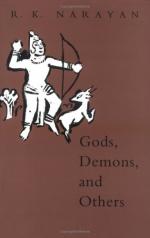|
This section contains 505 words (approx. 2 pages at 400 words per page) |

|
Gods, Demons, and Others Summary & Study Guide Description
Gods, Demons, and Others Summary & Study Guide includes comprehensive information and analysis to help you understand the book. This study guide contains the following sections:
This detailed literature summary also contains Topics for Discussion and a Free Quiz on Gods, Demons, and Others by R. K. Narayan.
Written by R.K. Narayan, who is regarded as one of India's greatest English language novelists, Gods, Demons and Others is a collection of some of the most well-known stories of Hindu mythology. They are taken, in part, from the ancient texts of 'The Ramayana', an epic hero's tale starring Rama, which is known in one form or another by every man, woman and child in the Indian society, and 'The Mahabharata', which is the other major epic tale of the culture, starring two rival families and chronicling their struggles. The stories of 'Viswamitra', 'Ravana' and 'Valmiki' are all taken from 'The Ramayana'. 'Yayati', 'Draupadi', 'Nala', 'Savitri', 'Shakuntala', 'Harischandra' and 'Sibi' are out of 'The Mahabharata'. The source of 'Lavana' and 'Chudala' is the 'Yoga-Vasishta'. The source of 'Devi' is the 'Devi Bhagavatam', and the source of 'Manmata' is the 'Shiva Purana'. Finally, 'The Mispaired Anklet' is from the Tamil epic 'Silapadikharam'.
Narayan included only stories that revolved around outstanding personalities, and he aimed at assembling as large a variety of characters as possible. It was his hope that taken together, they would provide the reader with a total picture of Indian mythology. These stories, as written within this text, are not meant to be taken as translations. In the preface of the work, Narayan explains that a storyteller reciting one of these stories orally to a crowd of villagers would often embellish it with long theological or didactic tangents, aimed at criticizing modern attitudes or expounding on a philosophy. Such tangents, if added to this volume, would expand it to epic and unpublishable proportions. While the storyteller, or narrator, is vital to any of these stories, Narayan has kept him in the background as much as possible unless he is needed to come forward with an explanation or introduction.
The storyteller, or Pandit, is really the crux of all the short stories in this collection. He is a key figure within the rural Indian community. At the end of a long, laborious day working in the fields, the members of a rural village would gather on the front doorstep of the storyteller's hut, wanting some entertainment. The stories that the storyteller would recite to the villagers were essentially road maps detailing how to properly live one's life, and the characters in these epics were considered prototypes and molds in which humanity is meant to be cast. Among the villagers, it would not matter if an individual was or was not literate. The oral tradition would insure that even those who could not read the written word would be able to participate. This is very important, as every story has within it philosophical or moral significance, and would outline the distinctions between good and evil. The collection of stories in this work are ones that would have been heard over and over again within the Indian culture, meant to be pondered over again and again, in order to engender within the listener an ever deepening understanding of life, death and destiny.
Read more from the Study Guide
|
This section contains 505 words (approx. 2 pages at 400 words per page) |

|



